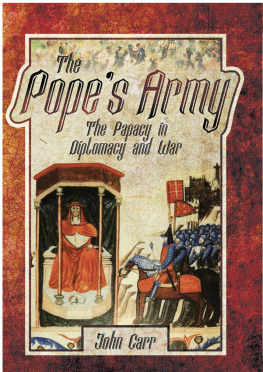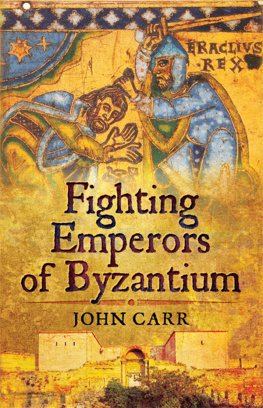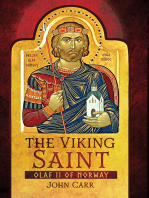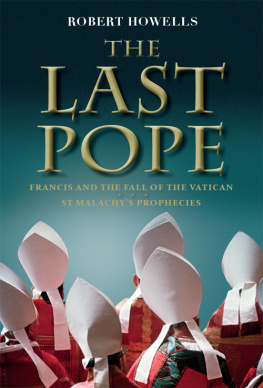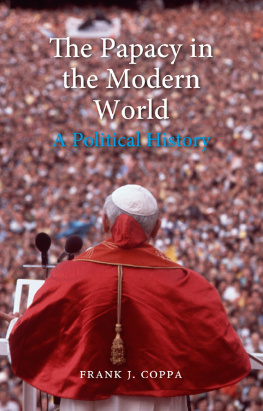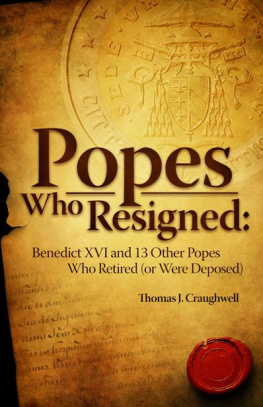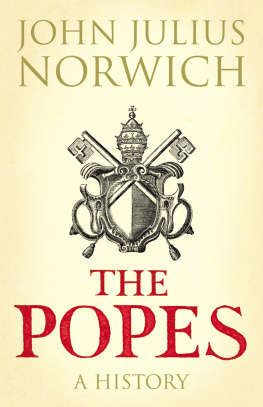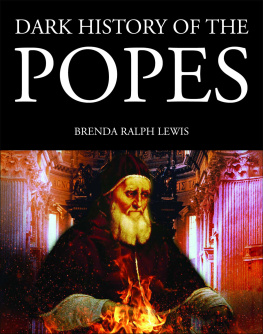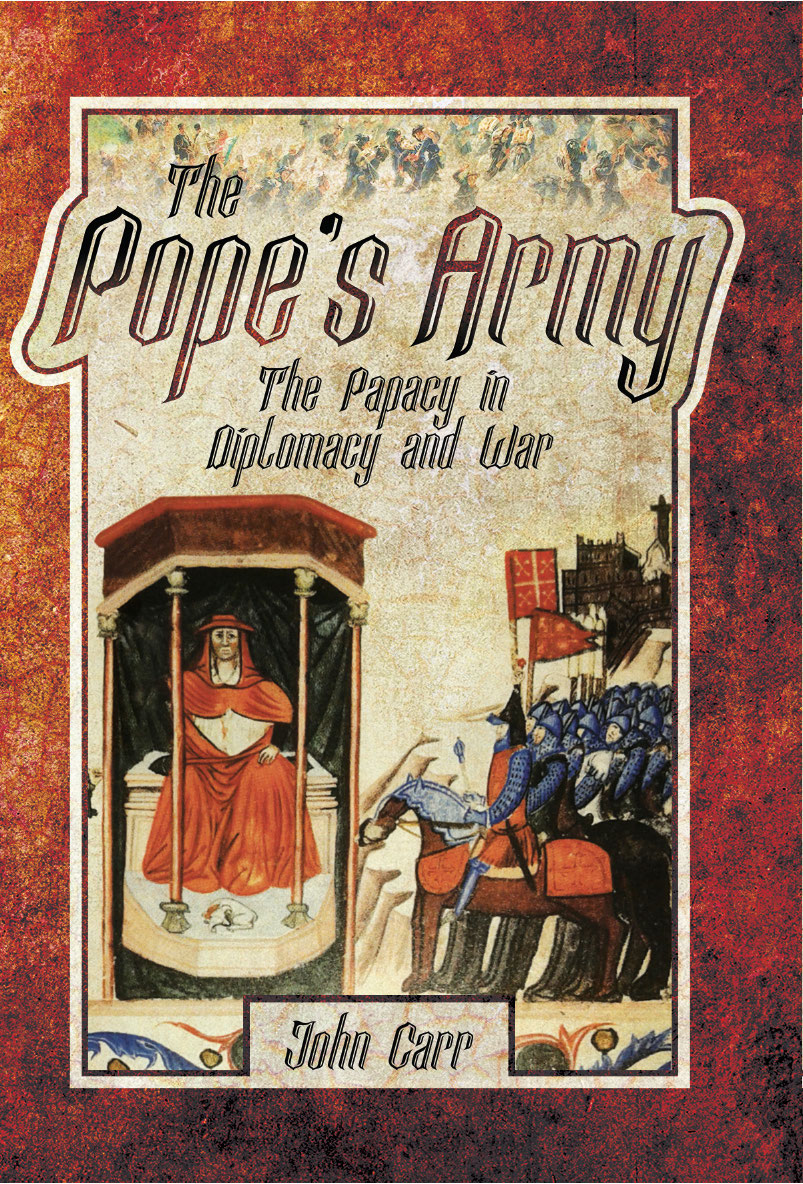The Popes Army
The Popes Army
The Papacy in Diplomacy and War
John Carr
Contents
First published in Great Britain in 2019 by
Pen & Sword Military
An imprint of
Pen & Sword Books Ltd
Yorkshire Philadelphia
Copyright John Carr 2019
ISBN 978 1 52671 489 3
eISBN 978 1 52671 491 6
Mobi ISBN 978 1 52671 490 9
The right of John Carr to be identified as Author of this work has been asserted by him in accordance with the Copyright, Designs and Patents Act 1988.
A CIP catalogue record for this book is available from the British Library.
All rights reserved. No part of this book may be reproduced or transmitted in any form or by any means, electronic or mechanical including photocopying, recording or by any information storage and retrieval system, without permission from the Publisher in writing.
Pen & Sword Books Limited incorporates the imprints of Atlas, Archaeology, Aviation, Discovery, Family History, Fiction, History, Maritime, Military, Military Classics, Politics, Select, Transport, True Crime, Air World, Frontline Publishing, Leo Cooper, Remember When, Seaforth Publishing, The Praetorian Press, Wharncliffe Local History, Wharncliffe Transport, Wharncliffe True Crime and White Owl.
For a complete list of Pen & Sword titles please contact
PEN & SWORD BOOKS LIMITED
47 Church Street, Barnsley, South Yorkshire, S70 2AS, England
E-mail: enquiries@pen-and-sword.co.uk
Website: www.pen-and-sword.co.uk
Or
PEN AND SWORD BOOKS
1950 Lawrence Rd, Havertown, PA 19083, USA
E-mail: Uspen-and-sword@casematepublishers.com
Website: www.penandswordbooks.com
List of Plates
1.Pope John VIII [Catholic Encyclopedia]
2.Pope Leo IX [www.catholicireland.net]
3.The Normans eject Pope Gregory VII from Rome, 1084 [Chronicle of Otto, 12th century]
4.Pope Boniface VIII arrests Pope Celestine V, 1295 [15th century print, Newton & Compton]
5.Cardinal Albornoz enters Rome with papal guard, August 1354 [Msgr. Charles Burns]
6.French troops in occupied Rome, c. 1799 [Paris: Vues des edifices de Rome antique dans lintrieur]
7.Soldier of the Noble Guard, c. 1801 [Newton & Compton]
8.Pope Pius VII [Basilica of San Paolo]
9.Pope Pius IX [Basilica of San Paolo]
10.Major Myles OReilly [OConnell family, online]
11.The Battle of Castelfidardo, 1860 [OConnell family, online]
12.A Zouave of the papal forces [Catholic Encyclopedia]
13.Nationalist bersaglieri breach Romes Porta Pia, 1870, by Carlo Ademollo [www.italiano-milano.org]
14.Pope Pius XI, who negotiated the Lateran Treaty of 1929 [Ferguson & Bruun]
15.Pope Pius XIIs condemnation of communism [official poster reprint]
16.Military-run aid centre in St. Peters Square, 1944 [Order of Malta]
17.Order of St. John aircrew and attendants on pilgrim mission to Lourdes, 1951 [Order of Malta]
18.A striking image of three Savoia-Marchetti SM82 ex-bombers in St. Johns markings over the Vatican, early 1950s [Order of Malta]
19.A Swiss Guard ceremonial line-up [Order of Malta]
20.Col. Mario Fine, commander of the Corpo Militare [Order of Malta]
Prologue
For Gods providence constantly uses war to correct and chasten the corrupt morals of mankind, as it also uses such afflictions to train men in a righteous and laudable way of life.
Saint Augustine (early fifth century)
His holiness, Pope Leo X, therefore, has found the pontificate in a very powerful condition, from which it is hoped that as those Popes made it great by force of arms, so he through his goodness and infinite other virtues will make it both great and venerated.
Niccol Machiavelli, The Prince (1513)
When Machiavelli jotted down his advice to statesmen that would become his acclaimed political analysis The Prince in the early sixteenth century, the Roman papacy was at the height of its powers. In the fourteen centuries since its beginnings with Saint Peter, the Roman Catholic Church had soared in spiritual stature, but at the same time had found it progressively more necessary to defend itself by force of arms against foes in Italy and elsewhere. Italy itself was in chaos. As long as it administered a political state based on Rome, the papacy was compelled to employ worldly and secular measures such as warfare to preserve its more important sacred and non-worldly inner nature. Without the Vatican state, we could not have done our worldwide job. That state could be likened to a walnut, whose tooth-breaking outer shell protects the delicate kernel inside. This is the story of that tough outer shell, as it were.
Anyone of a thoughtful cast of mind who picks up a book with the title of The Popes Army may well wonder what organized religion, as typified by the Catholic or any other faith, really has to do with the organized violence for which armies have existed since the beginning of time. The above quotation from Saint Augustine (in his massive work City of God) offers one explanation of why wars occur, though its doubtful if very many people from his time to ours have really learned the lesson. Christianity, it is argued, came into the world specifically to render superfluous the use of force in human affairs by transforming the person from within, from a warlike beast to a child of God. Then why, the argument goes, has it not succeeded? Why should even popes, who hold themselves (along with Protestant and Eastern Orthodox prelates) to be the personifiers of Christian charity, ever need armies?
This book will not pretend to philosophically dissect the issue, much less resolve it. However, there are two basic attitudes to take. The first is the atheist view that since religion is a fantasy anyway, there is really no issue to resolve; churches are just human organizations like all the others, with their interests and power plays and recourses to force to get their way. But that is a bleak vision indeed, and holds out little or no hope for the betterment of humanity. The second is what might be called a pragmatic Christian view: that even though Christianity is anti-violence in creed and outlook, its institutions in a fallen world often need to employ a fallen worlds instruments, including that form of deadly organized violence called war.
Could the Bible be a guide? Throughout the Old Testament we are regaled with fierce and bloody descriptions of the centuries-long battle of the Israelites against a variety of foes, with the writers leaving us with no doubt whose side they are on. Then the New Testament opens with a dramatic change in tone. In the description of Jesus arrest in the Gospel of Matthew (26: 512), we read of a disciple drawing his sword and chopping off an ear of the high priests servant. Put up again thy sword into his place, Jesus admonishes the attacker, for all that take the sword shall perish with the sword. The incident is retold in the gospels of Mark, Luke and John, with a few variations. Luke and John report that it was the servants right ear that was cut off; Luke adds that Jesus at once touched the mans wound and healed it, while John names the servant as Malchus but mentions no instantaneous healing. However, John provides the vital detail that it was none other than the disciple Peter who attacked the servant in the belief that he was defending his master Christ. As the Apostle Peter is credited as the founder of what grew into the Roman Catholic Church, it can be argued that he was the original one-man papal army.

